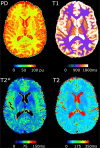Multiparametric Quantitative MRI in Neurological Diseases
- PMID: 33763021
- PMCID: PMC7982527
- DOI: 10.3389/fneur.2021.640239
Multiparametric Quantitative MRI in Neurological Diseases
Abstract
Magnetic resonance imaging (MRI) is the gold standard imaging technique for diagnosis and monitoring of many neurological diseases. However, the application of conventional MRI in clinical routine is mainly limited to the visual detection of macroscopic tissue pathology since mixed tissue contrasts depending on hardware and protocol parameters hamper its application for the assessment of subtle or diffuse impairment of the structural tissue integrity. Multiparametric quantitative (q)MRI determines tissue parameters quantitatively, enabling the detection of microstructural processes related to tissue remodeling in aging and neurological diseases. In contrast to measuring tissue atrophy via structural imaging, multiparametric qMRI allows for investigating biologically distinct microstructural processes, which precede changes of the tissue volume. This facilitates a more comprehensive characterization of tissue alterations by revealing early impairment of the microstructural integrity and specific disease-related patterns. So far, qMRI techniques have been employed in a wide range of neurological diseases, including in particular conditions with inflammatory, cerebrovascular and neurodegenerative pathology. Numerous studies suggest that qMRI might add valuable information, including the detection of microstructural tissue damage in areas appearing normal on conventional MRI and unveiling the microstructural correlates of clinical manifestations. This review will give an overview of current qMRI techniques, the most relevant tissue parameters and potential applications in neurological diseases, such as early (differential) diagnosis, monitoring of disease progression, and evaluating effects of therapeutic interventions.
Keywords: brain imaging; epilepsy; multiple sclerosis; neurodegeneration; neuroimaging; quantitative magnetic resonance imaging.
Copyright © 2021 Seiler, Nöth, Hok, Reiländer, Maiworm, Baudrexel, Meuth, Rosenow, Steinmetz, Wagner, Hattingen, Deichmann and Gracien.
Conflict of interest statement
EH has received speaker's honoraria from BRACCO. FR has received honoraria for presentations and consultations from Arvelle Therapeutics, EISAI, UCB Pharma, Novartis Oncology, Medtronic, GW-Pharmaceuticals, as well as research grants from UCB, European Union, Deutsche Forschungsgemeinschaft, European Science Foundation and the Hessonian Ministries of Science and Arts and of Social Affairs and Integration. HS has received speaker's honoraria from Bayer, Sanofi and Boehringer Ingelheim. The remaining authors declare that the research was conducted in the absence of any commercial or financial relationships that could be construed as a potential conflict of interest.
Figures
References
-
- Cercignani M, Dowell NG, Tofts P. editors. Quantitative MRI of the Brain: Principles of Physical Measurement. Boca Raton FL: CRC Press Taylor & Francis Group; (2018).
-
- Gracien R-M, Maiworm M, Brüche N, Shrestha M, Nöth U, Hattingen E, et al. . How stable is quantitative MRI? – Assessment of intra- and inter-scanner-model reproducibility using identical acquisition sequences and data analysis programs. Neuroimage. (2020) 207:116364. 10.1016/j.neuroimage.2019.116364 - DOI - PubMed
Publication types
LinkOut - more resources
Full Text Sources
Other Literature Sources


